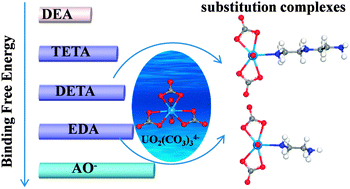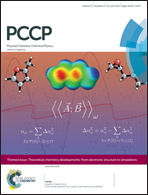Sequestering uranium from UO2(CO3)34− in seawater with amine ligands: density functional theory calculations†
Abstract
The polystyrene-supported primary amine –CH2NH2 has shown an at least 3-fold increase in uranyl capacity compared to a diamidoxime ligand on a polystyrene support. This study aims to understand the coordination of substitution complexes from UO2(CO3)34− and amines using density functional theory calculations. Four kinds of amines (diethylamine (DEA), ethylenediamine (EDA), diethylenetriamine (DETA) and triethylenetetramine (TETA)) were selected because they belong to different classes and have different chain lengths. The geometrical structures, electronic structures and the thermodynamic stabilities of various substitution complexes, as well as the trends in their calculated properties were investigated at equilibrium. In these optimized complexes, DEA groups bind to uranyl as monodentate ligands; EDA groups serve as monodentate and bidentate ligands; DETA groups act as monodentate and tridentate ligands; while TETA groups serve as monodentate, bidentate and tridentate ligands. The thermodynamic analysis confirmed that the primary amines coordinate to uranyl more strongly than does the secondary amine. The stabilities of substitution complexes with primary amines were calculated to decrease with increasing chain length of the amine, except for UO2(L2)2+. Of the complexes analyzed, only UO2L(CO3)22− (L = EDA and DETA) and UO2L2CO3 (L = EDA) were predicted to form from the substitution reactions with UO2(CO3)34− and protonated amines as reactants in aqueous solution. Amines were calculated to be comparable to, or sometimes weaker than, amidoximate in replacing CO32− in UO2(CO3)34− to coordinate to uranium. Therefore, the coordination mechanism, in which amines replace carbonates to bind to uranyl, is not primarily responsible for the experimentally observed 3-fold or greater increase in uranyl capacity of primary amines compared to a diamidoxime ligand. Based on the results of our calculations, we believe that the cation exchange mechanism, in which the protonated amines bind to uranyl tricarbonate directly, plays a leading role in the uranium recovery from seawater by amines.


 Please wait while we load your content...
Please wait while we load your content...